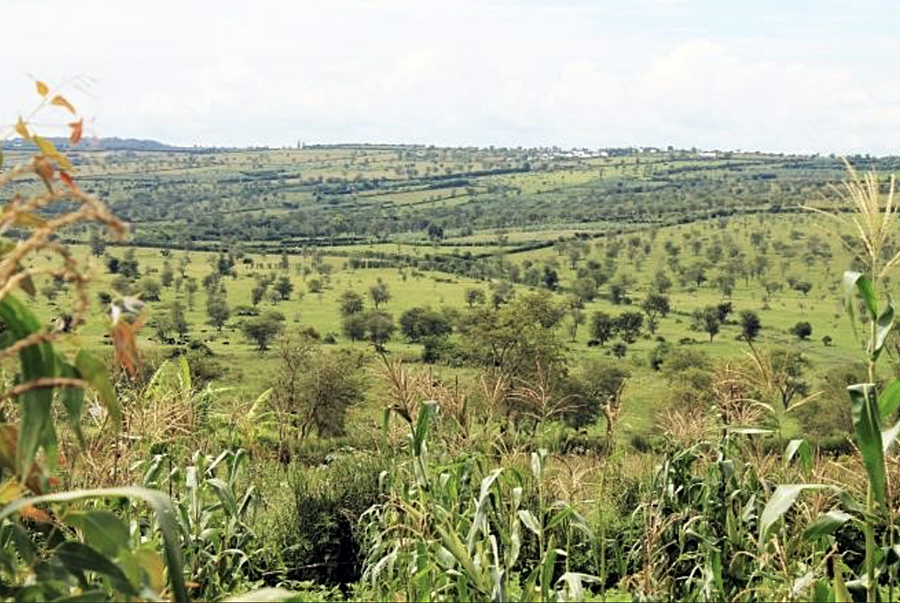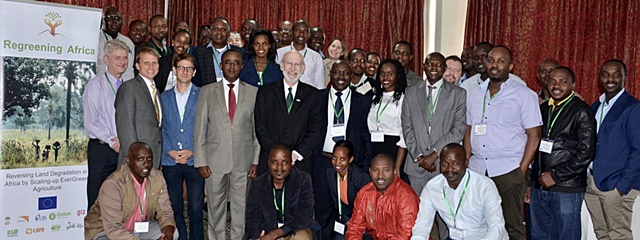BY · DECEMBER 21, 2018
Agroforestry will help the country meet its land-restoration targets.

Smallholder farms in Rwanda’s eastern Savannah region. Photo: World Agroforestry
Rwanda was the first African country to declare a target for land restoration, aiming for 2 million hectares by 2030, equivalent to 76% of its total land area. Agroforestry, also known simply as ‘trees on farms’, has been identified as one of the means to achieve this target.
Regreening Africa is a land-restoration project already underway in Rwanda, targeting 100,000 households on 70,000 hectares in four districts in the eastern Savannah region. It is funded by the European Union.
The Rwandan Ministry of Environment, World Agroforestry and World Vision Rwanda recently hosted a workshop under Regreening Africa to support implementation of the Agroforestry Strategy and Plan for Rwanda. Objectives of the workshop were to 1) review the evidence and benefits of integrating trees into agricultural landscapes; 2) identify opportunities for operationalizing the Strategy and Plan; and 3) collectively develop an operational plan for expanding the scale of agroforestry. Participants included government institutions, donors, NGOs, grassroots organizations and the private sector.
“Natural forests in Rwanda are protected yet farmers still need products and services from the forests. Integrating trees on farms will help farmers access these much-needed products and services,” said Athanase Mukuralinda, World Agroforestry’s representative in Rwanda. “The operationalization of the agroforestry strategy calls for coordination by government, civil society and the private sector.”
Rwanda’s strategy includes creating policy and institutional frameworks, research and knowledge building, strengthening communication and extension, promoting agroforestry practices, and marketing of products and value chains.
“The government of Rwanda recognizes the role of agriculture to meet restoration targets and improve livelihoods, said Hon Vincent Biruta, Minister of Environment. “We are committed to increase forest cover by 30% while reducing dependence on biomass and imported timber. We aim to increase tree and shrub cover to 150 per hectare.”

Dennis Garrity, UN Drylands Ambassador (centre, with beard), and workshop participants. Photo: World Agroforestry/Susan Onyango
“Rwanda looked far ahead of other countries in recognizing the challenge of land degradation caused by an increasing population, steeply sloping agricultural land and soil erosion,” said Dennis Garrity, senior distinguished fellow at World Agroforestry and Drylands Ambassador for the United Nations Convention to Combat Desertification. “Restoring our landscapes brings prosperity, security and opportunity. Potentially, agroforestry can be extended to about 1.5 million hectares across six land-use systems in Rwanda.”
Garrity made several recommendations for the implementation of the national agroforestry strategy:
- Launch a national food-security and land-restoration programme; and set a target of over 10% of tree-and-shrub cover on all farmland by 2030
- Develop a high-resolution, tree-and-shrub cover, baseline map for the whole country to track progress to 2030
- Set district land-restoration targets
- Mobilize agricultural-extension services
- Create a network on evergreening for land restoration that engages all NGOs, civil society and the private sector
“We need to] improve the quality and quantity of agroforestry by integrating value chains for products, integrating in the Crop Intensification Programme and by improving domestic financing and coordination with districts,” said Arnaud de Vanssay, head, Rural Development, Delegation of the European Union to Rwanda, in a panel discussion on how to make the agroforestry strategy work.
The workshop was conducted using the SHARED methodology for evidence-based decision making. Representatives from organizations in Rwanda shared their experience of the different ways they are implementing agroforestry initiatives. The workshop also mapped stakeholders in Rwanda to identify key actors that Regreening Africa could work with to increase the scale of regreening beyond the project’s areas, the roles of various stakeholders and what communication and advocacy approaches could be used in the project.
This story was produced with the financial support of the European Union. Its contents are the sole responsibility of the Regreening Africa project and do not necessarily reflect the views of the European Union.
